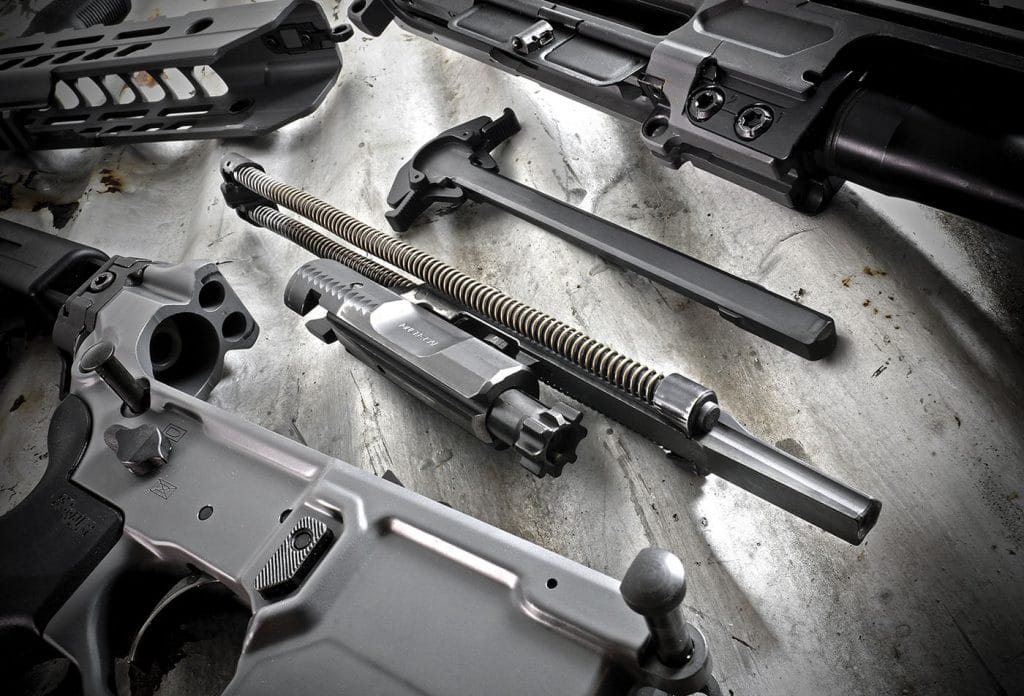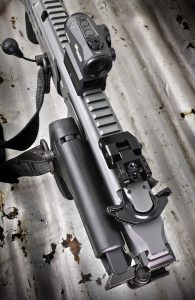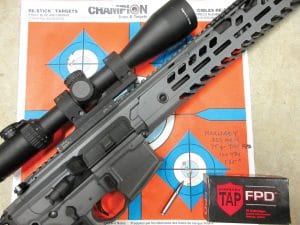
Range work with the MCX Virtus proved enjoyable if unsurprising. Over the course of three different sessions I put 300+ rounds through the Virtus. It ate everything I fed it, from six different types of common metal and polymer magazines. No stoppages or failures of any kind, and no lube whatsoever. Ejection was positive but not excessive, with spent casings falling to a perfect 3-o’clock about four feet away. All mags fed and fell free easily from the slightly flared mag well. At 7.9 pounds empty, the Virtus is not an ultralight but not heavy either, with balance favoring slightly forward. The Virtus handled nimbly, was quick to shoulder, with the ambidextrous controls simple to manipulate. Recoil was soft and manageable, making it easy to take good follow up shots. I particularly liked the proprietary Sig pistol grip, which is similar to a Magpul K2. The MLOK fore end provided an excellent gripping surface, and just as importantly stayed cool during rapid fire strings. Inside ten or so rounds I had the Virtus it dialed in at 50 yards using an Aimpoint T1 on a Larue mount, and proceeded to merrily bang away from a variety of conventional and unconventional shooting positions. A few friends who shot the Virtus were likewise duly impressed.

Later, dedicated accuracy testing proved a tad frustrating. This was for two reasons. First, the rather skinny, minimalist stock riding on its tiny I-beam is not entirely optimal for the cheek weld or support necessary to determine true intrinsic accuracy. If this were my personal Virtus, I would likely invest $150 or so in the adaptor Sig Sauer offers for utilizing a receiver extension tube to take any mil spec AR stock. Second, and more significantly, there was me. I was frankly not at the top of my game the day of final accuracy testing. It had already been a long week, and it was only Tuesday. But, deadline looming, I endeavored to persevere. Topped with my Trijicon 4-16x AccuPower on a Larue SPR 1.5 QD mount and shooting from a bench at 100 yards, the Virtus shot an average of about two inches with most of the six different types of ammo I put through it. Under normal circumstances this would be considered quite acceptable, but I knew it could be better. Often I would have four rounds at about an inch, but throw a flyer to open things up despite the Virtus’ very good two-stage trigger. (Insert deleted expletive here). The best groups, not unexpectedly given the Virtus 1:7 barrel twist, came from Hornady .223 75-gr. TAP FPD at 1.25 inches, with the best four in .75 inches. However, Freedom Munitions 5.56mm 55-gr. remanufactured rounds also took honorable mention at two inches for most groups, with similar MOA best-four patterns despite being the bargain ammo. Go figure.

Bottom line, I firmly believe that the Virtus is capable of consistent MOA groups or better, especially with a standard AR stock and more skilled driver behind it. Regardless, as is the Virtus is capable of excellent practical accuracy, which combined with its many other redeeming qualities is what really matters. To prove that, I decided to end the day with a modified Navy Qual drill, both in and attempt to feel better about myself, and employ the rifle in the manner in which it was primarily designed—moving and fighting at typical engagement ranges. Result: 140 of 15 rounds (5 standing, 5 kneeling and 5 prone with two bolt-lock reloads) inside eight inches at 50 yards with a time of 26.5 seconds. Score: 9 or expert (barely), even by tier 1 operator standards. Mojo recovered.

The Sig MCX Virtus was everything I expected it to be, and I expected a lot. It is no surprise the MCX is the choice of top end professional gunfighters, and I anticipate this new version will be part of their kit in the not too distant future, if it’s not already. As for price, some say Sig Sauer is a bit too proud of their firearms. However, its also true you usually get what you pay for. At a cost north of $2200, the Sig MCX Virtus is not the cheapest tactical carbine out there, and it will be out of reach for some, though for many of them (including me) it is probably more of a want than a need. But for those who can afford the best and demand it based on their mission requirements, the Virtus may be the ticket. See it at your firearms retailer, or contact Sig Sauer, Dept. OT; Tel.: (603) 610-3000; Web: www.sigsauer.com



















